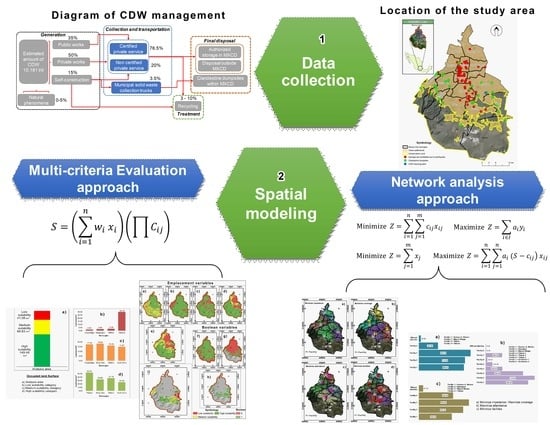Selection of Sites for the Treatment and the Final Disposal of Construction and Demolition Waste, Using Two Approaches: An Analysis for Mexico City
Abstract
:1. Introduction
2. Materials and Methods
2.1. Description of the Study Area
2.2. CDW Management in MXCD
2.3. Spatial Analysis Methodologies
2.3.1. Emplacement by MCE
2.3.2. Emplacement by network analysis
3. Results and Discussion
3.1. MCE Approach
3.2. Network Analysis Approach
3.3. Final Considerations
4. Conclusions
Author Contributions
Funding
Acknowledgments
Conflicts of Interest
References
- Sapuay, S. Construction Waste–Potentials and Constraints. Procedia Environ. Sci. 2016, 35, 714–722. [Google Scholar] [CrossRef]
- Zhou, L.; Lowe, J. Economic Challenge of Sustainable Construction. In Proceedings of the RICS Construction and Building Research Conference, School of Engineering and the Built Environmental, University of Wolverhampton, Wolverhampton, UK, 1–2 September 2003; Proverbs, D., Ed.; RICS Foundation: London, UK, 2003; pp. 113–126. [Google Scholar]
- Kucukvar, M.; Tatari, O. Towards a triple bottom-line sustainability assessment of the U.S. construction industry. Int. J. Life Cycle Assess 2013, 18, 958–972. [Google Scholar] [CrossRef]
- Zuo, J.; Zhao, Z. Green building research–current status and future agenda: A review. Renew. Sustain. Energy Rev. 2014, 30, 271–281. [Google Scholar] [CrossRef]
- Research Office. Legislative Council Secretariat. Construction Industry in Hong Kong: Statistical Highlights, ISSH07/18-19. Available online: https://www.legco.gov.hk/research-publications/english/1819issh07-construction-industry-in-hong-kong-20181121-e.pdf (accessed on 23 January 2019).
- Mexican Chamber of the Construction Industry. Management Plan for Construction and Demolition Waste. Available online: https://www.cmic.org.mx/comisiones/Sectoriales/medioambiente/Flayer/PM%20RCD%20Completo.pdf (accessed on 20 January 2019).
- Shen, L.; Lu, W.; Yao, H.; Wu, D. A computer-based scoring method for measuring the environmental performance of construction activities. Automat. Constr. 2005, 14, 297–309. [Google Scholar] [CrossRef]
- Chen, Z.; Li, H.; Wong, C. Environmental Management of Urban Construction Projects in China. J. Constr. Eng. Manag. 2000, 126, 320–324. [Google Scholar] [CrossRef]
- Gangolells, M.; Casals, M.; Gassó, S.; Forcada, N.; Roca, X.; Fuertes, A. A methodology for predicting the severity of environmental impacts related to the construction process of residential buildings. Build. Environ. 2009, 44, 558–571. [Google Scholar] [CrossRef] [Green Version]
- Ballesteros, M.; Fernández, M.; Quintana, S.; Ballesteros, J.; González, I. Noise emission evolution on construction sites. Measurement for controlling and assessing its impact on the people and on the environment. Build. Environ. 2010, 45, 711–717. [Google Scholar] [CrossRef]
- Zolfagharian, S.; Nourbakhsh, M.; Irizarry, J.; Ressang, A.; Gheisari, M. Environmental Impacts Assessment on Construction Sites; Construction Research Congress; American Society of Civil Engineers: Reston, VA, USA, 2012; pp. 1750–1759. [Google Scholar]
- Lingard, H.; Gilbert, G.; Graham, P. Improving solid waste reduction and recycling performance using goal setting and feedback. Construct. Manag. Econ. 2001, 19, 809–817. [Google Scholar] [CrossRef]
- Kartam, N.; Al-Mutairi, N.; Al-Ghusain, I.; Al-Humond, J. Environmental management of construction and demolition waste in Kuwait. Waste Manag. 2004, 24, 1049–1059. [Google Scholar] [CrossRef]
- Poon, C.; Yu, A.; See, S.; Cheung, E. Minimizing demolition wastes in Hong Kong public housing projects. Construct. Manag. Econ. 2004, 22, 799–805. [Google Scholar] [CrossRef]
- Tan, A.; Ofori, G.; Briffett, C. ISO 14000: Its relevance to the construction industry of Singapore and its potential as the next industry milestone. J. Construct. Manag. Econ. 1999, 17, 449–461. [Google Scholar]
- Zeng, S.; Tian, P.; Shi, J. Implementing integration of ISO 9001 and ISO 14001 for construction. Manag. Audit. J. 2005, 20, 394–407. [Google Scholar] [CrossRef]
- Arana, G.; Heras, I.; Cilleruelo, E. A case study of the adoption of a reference standard for ISO 14006 in the lift industry. Clean Technol. Environ. Policy 2012, 14, 641–649. [Google Scholar] [CrossRef]
- DOF, Official Journal of the Federation. Official Mexican Standard NOM-161-SEMARNAT-2011. Official Mexican Standard NOM-161-SEMARNAT-2011. Criteria for Classifying the Special Management Wastes and Determining Which are Subject to a Management Plan, the List of Them, the Procedure for Inclusion or Exclusion to That List; as Well as the Elements and Procedures for the Formulation of the Management Plans. Official Journal of the Federation, Published on 2 January 2013. Available online: http://www.dof.gob.mx/nota_detalle.php?codigo=5286505&fecha=01/02/2013 (accessed on 23 January 2019).
- GODF, Official Gazette of the Federal District. Environmental Standard for the Federal District NADF-007-RNAT-2013, Which Establishes the Classification and Management Specifications for Construction and Demolition Wastes, in the Federal District. Published on 26 February 2015. Available online: https://www.cmic.org.mx/comisiones/Sectoriales/medioambiente/PROY-NADF-007-RNAT-2013/Gaceta_DF_NADF-007-RNAT-2013.pdf (accessed on 23 January 2019).
- Wong, E.; Yip, R. Promoting sustainable construction waste management in Hong Kong. Construct. Manag. Econ. 2004, 22, 563–566. [Google Scholar] [CrossRef]
- Samari, M.; Esmaeilifar, R.; Shafiei, W. Green Building: Strategic Approach to Sustainable Economy. Int. J. Bus. Manag. 2014, 2, 198–202. [Google Scholar]
- Xu, X.; Wang, Y.; Tao, L. Comprehensive evaluation of sustainable development of regional construction industry in China. J. Clean. Prod. 2019, 211, 1078–1087. [Google Scholar] [CrossRef]
- National Institute of Statistic and Geography. Mexico City: Information by State. Available online: http://cuentame.inegi.org.mx/monografias/informacion/df/default.aspx?tema=me&e=09 (accessed on 23 January 2019).
- GODF, Official Gazette of the Federal District. Decree of the General Program of Ecological Planning of the Federal District. Published on 1 August 2000. Available online: http://www.cms.sedema.cdmx.gob.mx/storage/app/uploads/public/595/138/60b/59513860b02f7865727855.pdf (accessed on 23 January 2019).
- Government of the Federal District (GDF). Geographical Atlas of the Conservation Land of the Federal District; Secretariat of Environment—Environmental and Territorial Planning Office of the Federal District: Mexico, Mexico, 2012; p. 96.
- Environmental and Territorial Planning Office of the Federal District. Promotion of the Environmental and Territorial Rights of the Inhabitants of the Federal District—Annual Report 2003—Land use. Available online: http://centro.paot.org.mx/documentos/paot/informes/informe2003_borrame/ (accessed on 23 January 2019).
- UNAM, Universidad Nacional Autónoma de México. Methodology for Locating Final Disposal Sites for Construction and Demolition Waste Using Geographic Information Systems: Case Study Mexico City; Technical Report; National Autonomous University of Mexico—Secretariat of Science, Technology and Innovation: Mexico City, Mexico, 2017; p. 261. [Google Scholar]
- SOBSE, Secretariat of Works and Services. Demolitions in Mexico City. Available online: https://www.obras.cdmx.gob.mx/comunicacion (accessed on 23 January 2019).
- SEDEMA, Secretariat of Environment. Directory of Collection Centers for Municipal Solid Waste and Construction Waste in Mexico City. Government of Mexico City-Secretariat of Environment of Mexico City. Available online: http://data.sedema.cdmx.gob.mx/nadf24/images/infografias/planes_de_manejo_autorizados.pdf (accessed on 23 January 2019).
- SEDEMA, Secretariat of Environment. Solid Waste Inventory of Federal District, 2010; Federal District Government—Secretariat of Environment of Federal District: Mexico City, Mexico, 2010; p. 45.
- SEDEMA, Secretariat of Environment. Solid Waste Inventory of Federal District, 2011; Federal District Government- Secretariat of Environment of Federal District: Mexico City, Mexico, 2011; p. 44.
- SEDEMA, Secretariat of Environment. Solid Waste Inventory of Federal District, 2012; Federal District Government- Secretariat of Environment of Federal District: Mexico City, Mexico, 2012; p. 135.
- SEDEMA, Secretariat of Environment. Solid Waste Inventory of Mexico City, 2014; Mexico City Government- Secretariat of Environment of Mexico City: Mexico City, Mexico, 2014; p. 138.
- SEDEMA, Secretariat of Environment. Solid Waste Inventory of Mexico City, 2015; Mexico City Government- Secretariat of Environment of Mexico City: Mexico City, Mexico, 2015; p. 114.
- SEDEMA, Secretariat of Environment. Solid Waste Inventory of Mexico City, 2016; Mexico City Government- Secretariat of Environment of Mexico City: Mexico City, Mexico, 2016; p. 158.
- SEDEMA, Secretariat of Environment. Authorized Sites for Transfer and Temporary Storage of Construction Waste in Mexico City. Government of Mexico City-Secretariat of Environment of Mexico City. Available online: http://148.243.232.122/deia/download/declaratorias/Sitios_de_Tiro_Autorizados_10-2017.pdf> (accessed on 23 January 2019).
- PAOT, Environmental and Territorial Planning Office of the Federal District. Study of Areas Damaged by Clandestine Dumps of Construction Waste in the Federal District; Environmental and Territorial Planning Office of the Federal District: Mexico, D.F., Mexico, 2010; p. 124.
- Gómez, M.; Barredo, J. Geographic Information Systems and Multicriteria Evaluation in Territorial Planning; Ra-Ma Editorial: Madrid, Spain, 2005; p. 304. [Google Scholar]
- Eastman, J.; Jin, W.; Kyem, P.; Toledano, J. Raster procedures for Multi-Criteria/Multi-objective Decisions. Photogramm. Eng. Rem. S. 1995, 61, 539–547. [Google Scholar]
- Malczewski, J. On the Use of Weighted Linear Combination Method in GIS: Common and Best Practice Approaches. Trans. GIS 2000, 4, 5–22. [Google Scholar] [CrossRef]
- Alavi, N.; Goudarzi, G.; Babaei, A.; Jaafarzadeh, N.; Hosseinzadeh, M. Municipal solid waste landfill site selection with geographic information systems and analytical hierarchy process: A case study in Mahshahr County, Iran. Waste Manag. Res. 2013, 31, 98–105. [Google Scholar] [CrossRef]
- Demesouka, O.; Vavatsikos, A.; Anagnostopoulos, K. Suitability analysis for siting MSW landfills and its multicriteria spatial decision support system: Method, implementation and case study. Waste Manag. 2013, 33, 1190–1206. [Google Scholar] [CrossRef]
- Rafiee, R.; Khorasani, N.; Mahiny, A.; Darvishsefat, A.; Danekar, A.; Hasan, S. Siting Transfer Stations for Municipal Solid Waste Using a Spatial Multi-Criteria Analysis. Environ. Eng. Geosci. 2011, 17, 143–154. [Google Scholar] [CrossRef]
- Bosompem, C.; Stemn, E.; Fei-Baffoe, B. Multi-criteria GIS-based siting of transfer station for municipal solid waste: The case of Kumasi Metropolitan Area, Ghana. Waste Manag. Res. 2016, 34, 1054–1063. [Google Scholar] [CrossRef]
- Tavares, G.; Zsigraiová, Z.; Semiao, V. Multi-criteria GIS-based siting of an incineration plant for municipal solid waste. Waste Manag. 2011, 31, 1960–1972. [Google Scholar] [CrossRef]
- Araiza, J.; Nájera, H.; Gutiérrez, R.; Rojas, M. Emplacement of solid waste management infrastructure for the Frailesca region, Chiapas, México, using GIS tools. Egypt. J. Remote Sens. Space Sci. 2018, 21, 391–399. [Google Scholar] [CrossRef]
- Banias, G.; Achillas, C.; Vlachokostas, C.; Moussiopoulos, N.; Tarsenis, S. Assessing multiple criteria for the optimal location of a construction and demolition waste management facility. Build. Environ. 2010, 45, 2317–2326. [Google Scholar] [CrossRef]
- Dosal, E.; Coronado, M.; Muñoz, I.; Viguri, J.; Andres, A. Application of multi-criteria decision-making tool to locate construction and demolition waste (C&DW) recycling facilities in a northern Spanish region. Environ. Eng. Manag. J. 2012, 11, 545–556. [Google Scholar]
- Saaty, T.L. How to make a decision: The Analytic Hierarchy Process. Eur. J. Oper. Res. 1990, 48, 9–26. [Google Scholar] [CrossRef]
- Saaty, T.L. The Analytic Hierarchy Process; McGraw-Hill: New York, NY, USA, 1980. [Google Scholar]
- Church, R. Geographical information systems and location science. Comput. Oper. Res. 2002, 29, 541–562. [Google Scholar] [CrossRef]
- Valeo, C.; Baetz, B.; Tsanis, I. Locations of recycling depots with GIS. J. Urban Plan. D-ASCE 1998, 124, 93–99. [Google Scholar] [CrossRef]
- Vijay, R.; Gautam, A.; Kalamdhad, A.; Gupta, A.; Devotta, S. GIS-based locational analysis of collection bins in municipal solid waste management systems. J. Environ. Eng. Sci. 2008, 7, 39–43. [Google Scholar] [CrossRef]
- Aremu, A.; Sule, B.; Downs, J.; Mihelcic, J. Framework to Determine the Optimal Spatial Location and Number of Municipal Solid Waste Bins in a Developing World Urban Neighborhood. J. Environ. Eng. ASCE 2012, 138, 645–653. [Google Scholar] [CrossRef]
- Blanco, A. Localización óptima de contenedores de residuos sólidos urbanos en Alcalá de Henares. M+A. Rev. Electrón. Medioambient. 2016, 17, 1–23. [Google Scholar] [CrossRef]
- Environmental Systems Research Institute. Location-Allocation Analysis. Available online: https://desktop.arcgis.com/en/arcmap/10.5/extensions/network-analyst/location-allocation.htm#ESRI_SECTION1_F8182D9F421E4EA4AEE11E7B360E1340 (accessed on 23 January 2019).
- Densham, P.; Rushton, G. Strategies for solving large location-allocation problems by heuristic methods. Environ. Plan. A. 1992, 24, 289–304. [Google Scholar] [CrossRef]
- Church, R. Location modelling and GIS. In Geographical Information Systems: Principles, Techniques, Management and Applications, 2nd ed.; Longley, P., Goodchild, M., Maguire, D., Rhind, D., Eds.; Wiley: New York, NY, USA, 1999; Volume 1, pp. 293–303. [Google Scholar]
- Buzai, G. Location-allocation Models Applied to Urban Public Services: Spatial Analysis of Primary Care Service centers (PCSC) in the City of Luján, Argentina. Rev. Colomb. Geogr. 2011, 20, 111–123. [Google Scholar] [CrossRef]
- INEGI, National Institute of Statistic and Geography. Urban Geo-statistics Cartography-Federal District. Available online: https://www.inegi.org.mx/app/mapas/?t=0710000000000000&tg=3604 (accessed on 23 January 2019).
- SCC, Secretariat of Citizen Security. Speed limits. Available online: http://data.ssp.cdmx.gob.mx/reglamentodetransito/limites_velocidad.html (accessed on 23 January 2019).
- Hakimi, S. Optimum location of switching centers and the absolute centers and medians of a graph. Oper. Res. 1964, 12, 450–459. [Google Scholar] [CrossRef]
- Hakimi, S. Optimum distribution of switching centers in a communication network and some related graph theoretic problems. Oper. Res. 1965, 13, 462–475. [Google Scholar] [CrossRef]
- Miller, H.; Shaw, S. Geographic Information Systems for Transportation: Principles and Applications; Oxford University Press: New York, NY, SA, 2001; p. 458. [Google Scholar]
- Church, R.; ReVelle, C. The maximal covering location problem. Pap. Reg. Sci. 1974, 32, 101–118. [Google Scholar] [CrossRef]
- Toregas, C.; Swain, R.; ReVelle, C.; Bergman, L. The location of emergency service facilities. Oper. Res. 1971, 19, 1363–1373. [Google Scholar] [CrossRef]
- Marianov, V.; ReVelle, C. The Queuing Probabilistic Location Set Covering Problem and Some Extensions. Socio-Econ. Plan. Sci. 1994, 28, 167–178. [Google Scholar]
- Rajagopalan, H.; Saydam, C.; Xiao, J. A multiperiod set covering location model for dynamic redeployment of ambulances. Comput. Oper. Res. 2008, 35, 814–826. [Google Scholar] [CrossRef]
- Holmes, J.; Williams, F.; Brown, L. Facility Location under a maximum Travel Restriction: An example Using Day Care facilities. Geogr. Anal. 1972, 4, 258–266. [Google Scholar] [CrossRef]
- DOF, Official Journal of the Federation. Official Mexican Standard NOM-083-SEMARNAT-2003. Specifications for Environmental Protection Related to the Site Selection, Design, Construction, Monitoring, Closure and Complementary Works of a Final Disposal Site for Urban Solid Waste and of Special Management. Official Journal of the Federation, Published on 20 October 2004. Available online: http://www.dof.gob.mx/nota_detalle.php?codigo=5402726&fecha=04/08/2015 (accessed on 10 January 2019).
- GGSM, Government Gazette of the State of Mexico. State Environmental Technical Standard. NTEA-010-SMA-RS-2008. Requirements and Specifications for the Installation, Operation and Maintenance of Infrastructure for the Collection, Transfer, Separation and Treatment of Urban Solid Waste and Special Management for the State of Mexico. Published on 21 May 2009. Available online: http://sma.edomex.gob.mx/sites/sma.edomex.gob.mx/files/files/sma_pdf_ntea_010_sma_rs_2008.pdf (accessed on 23 January 2019).
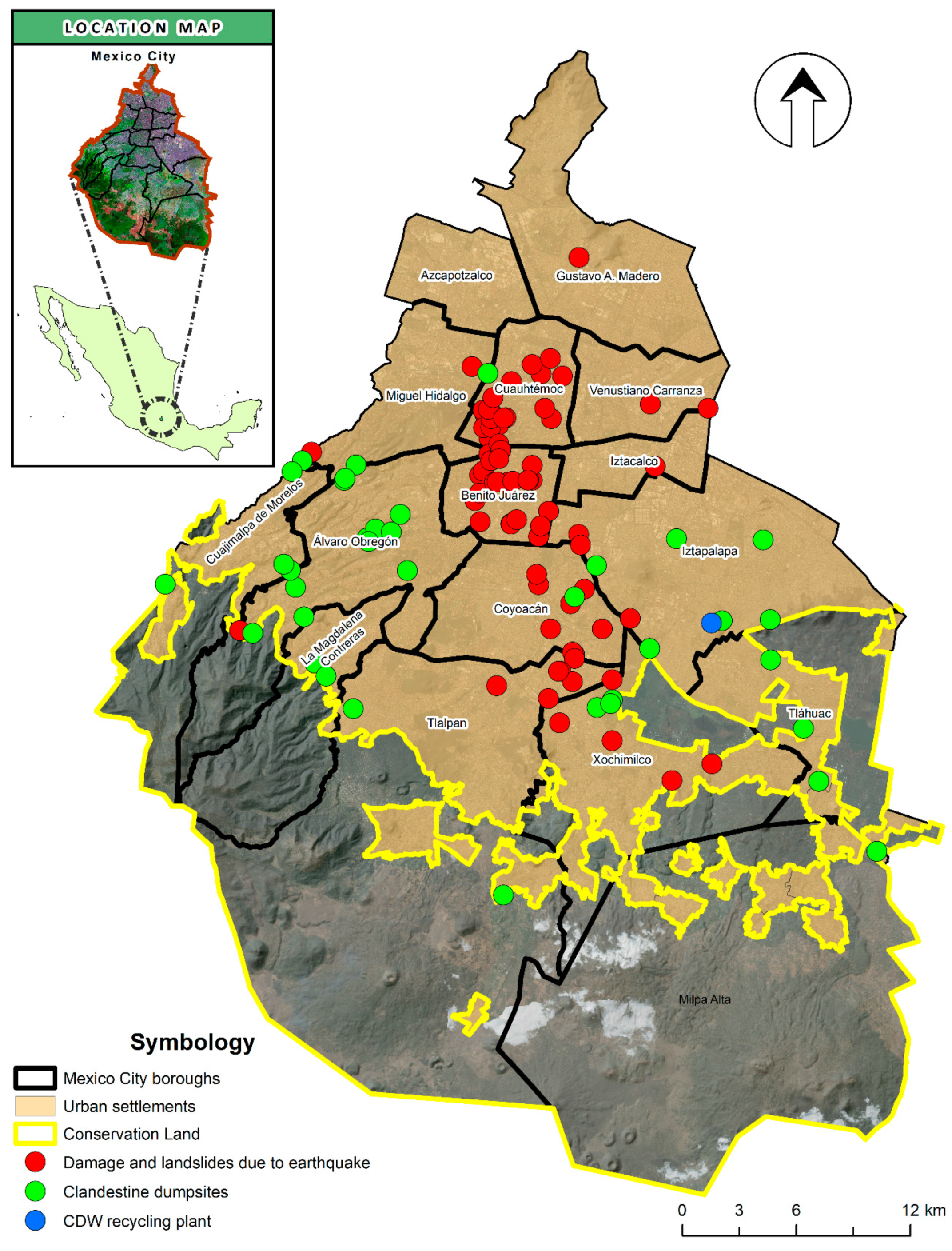
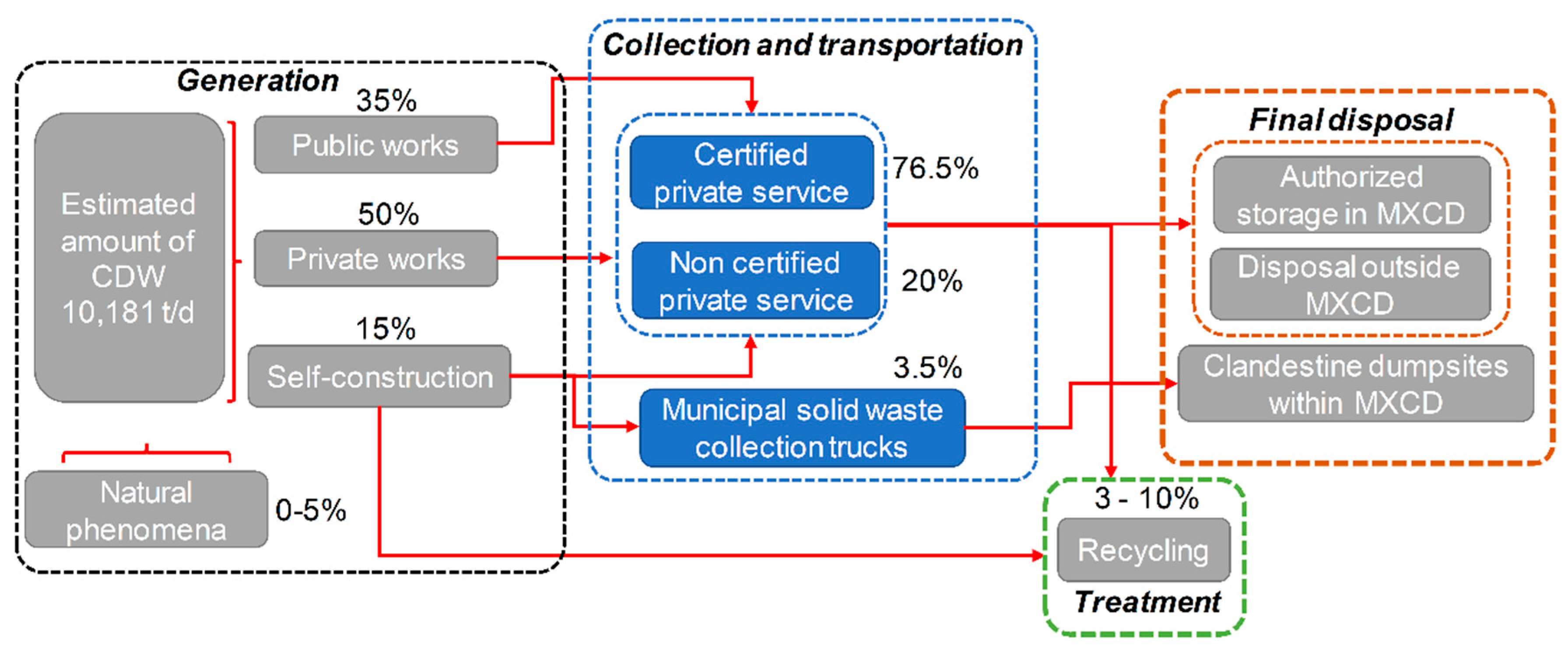
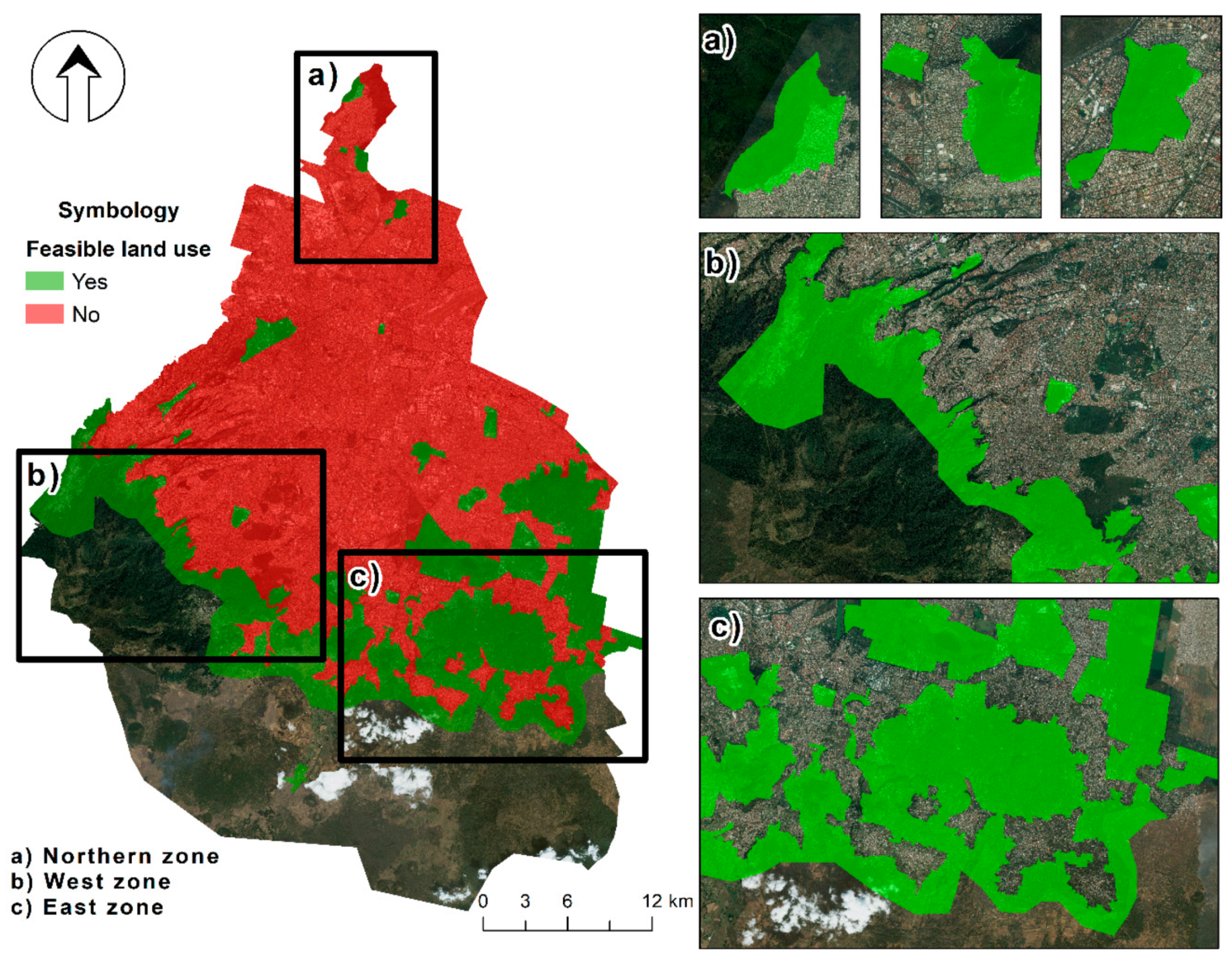
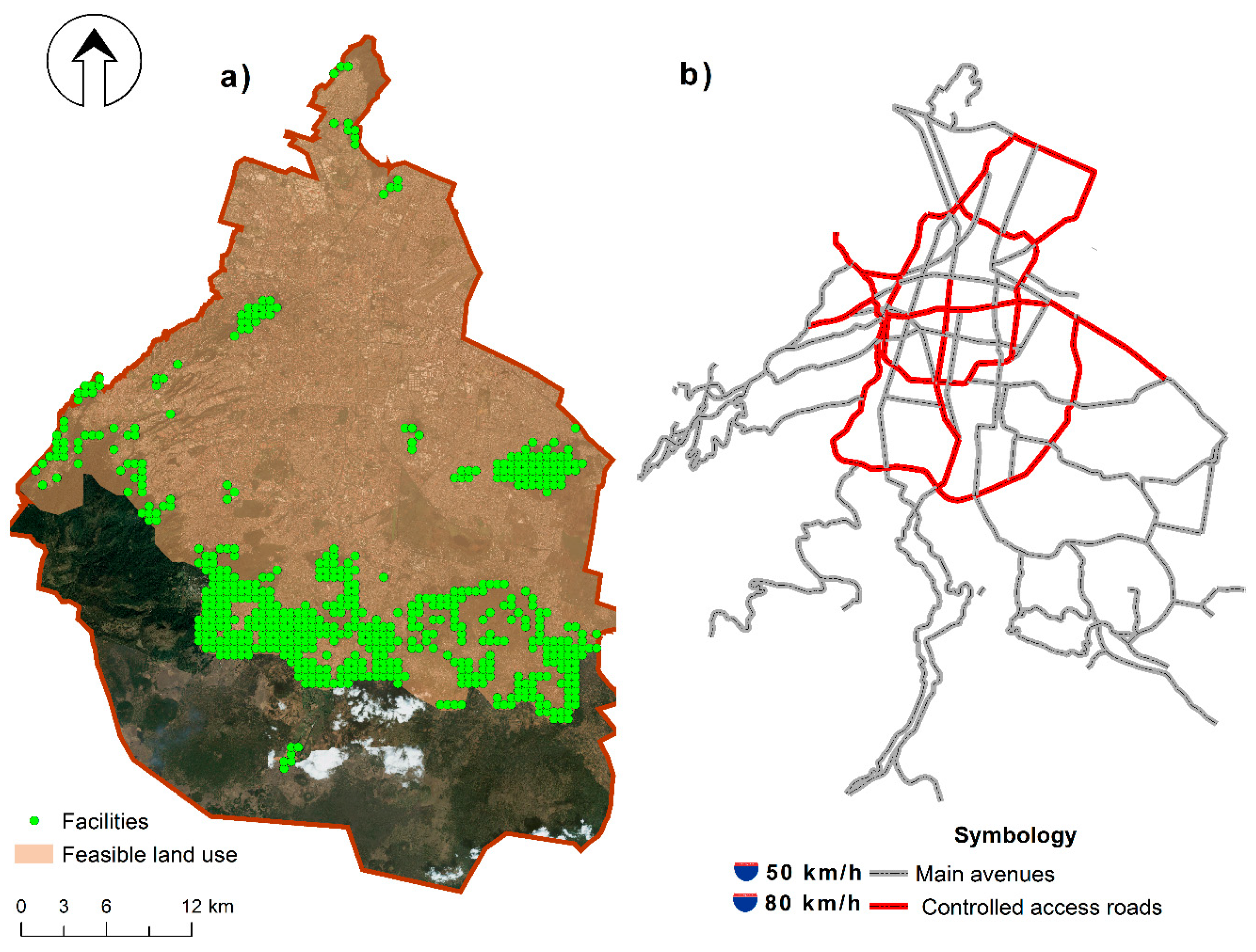
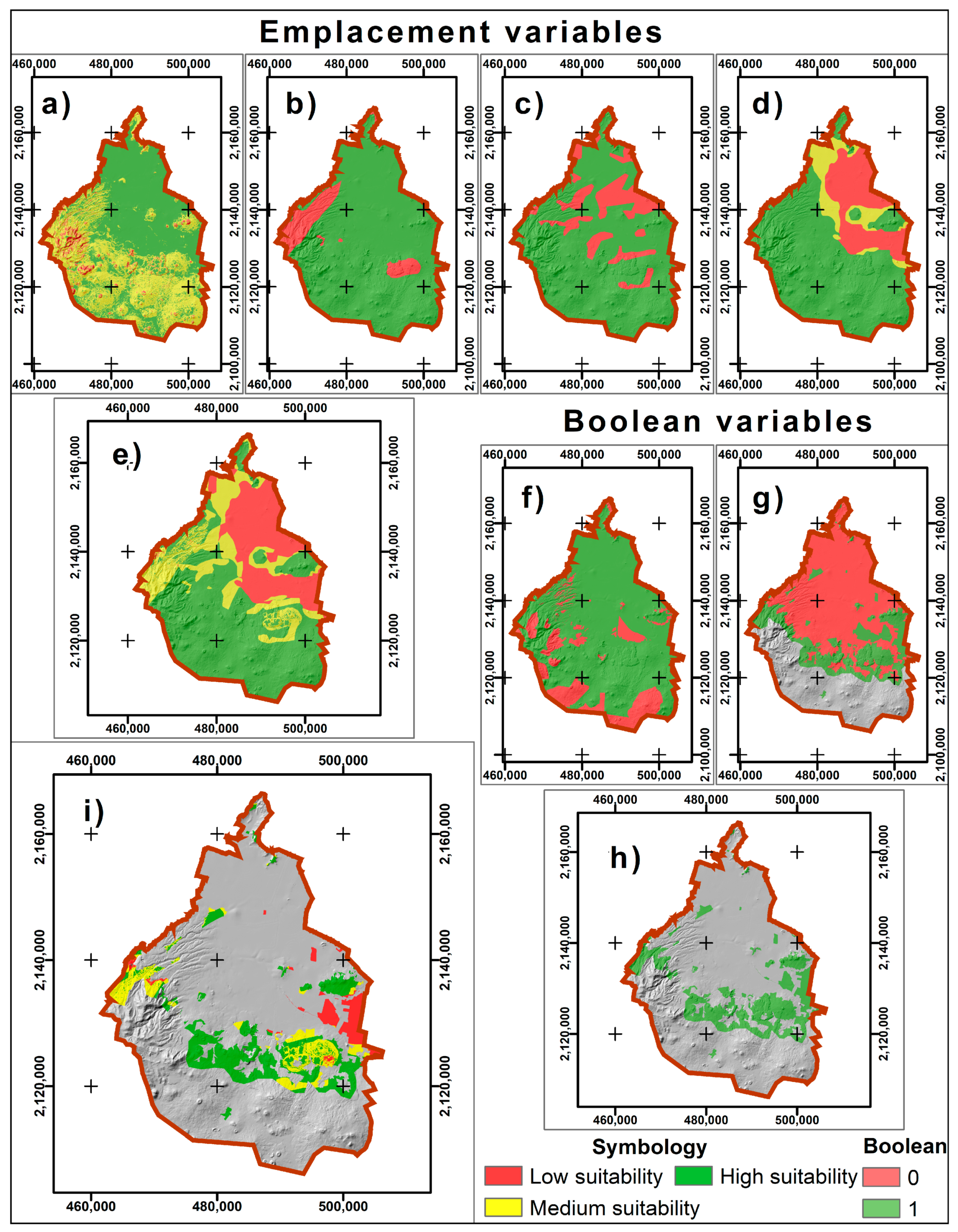
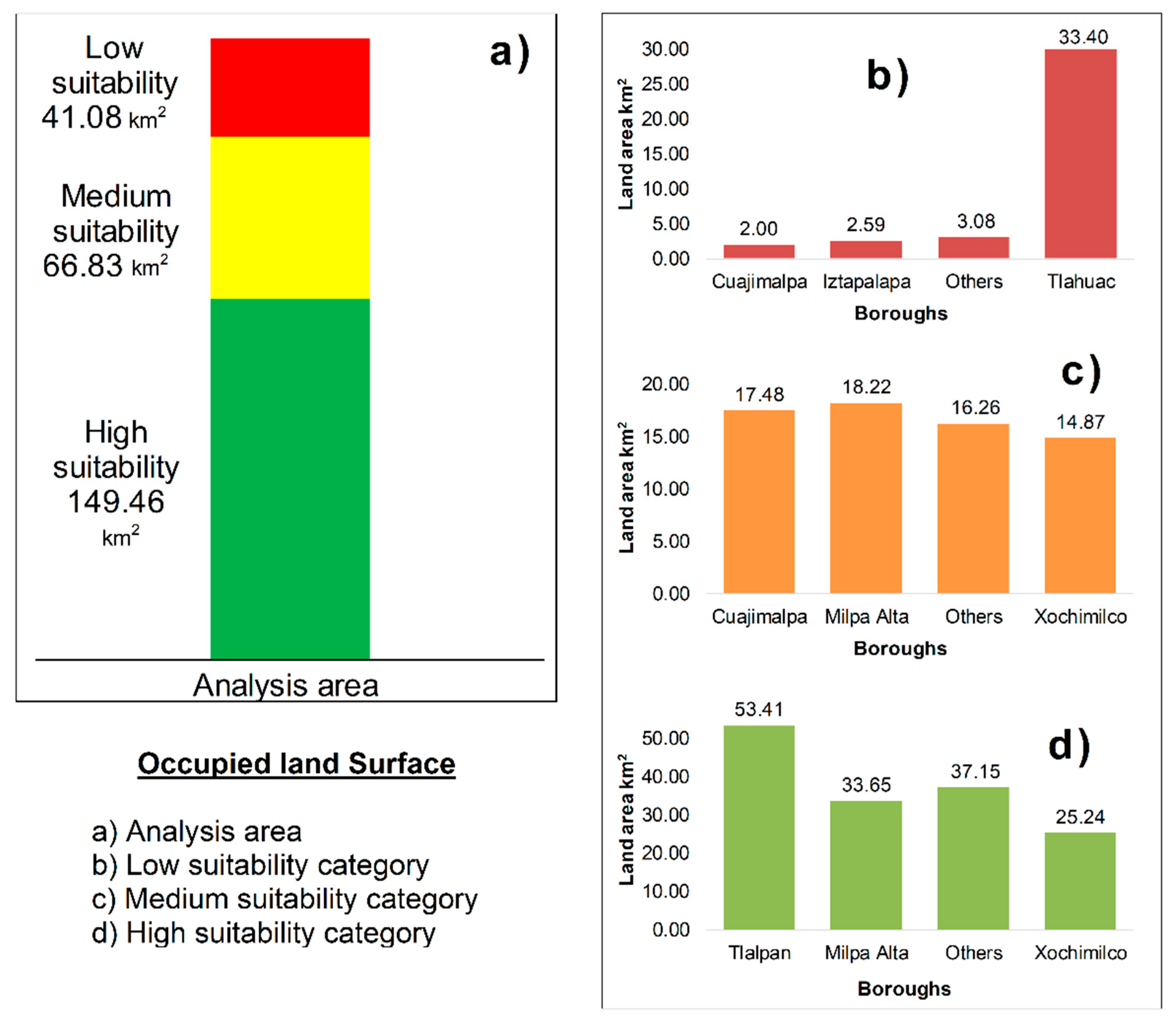
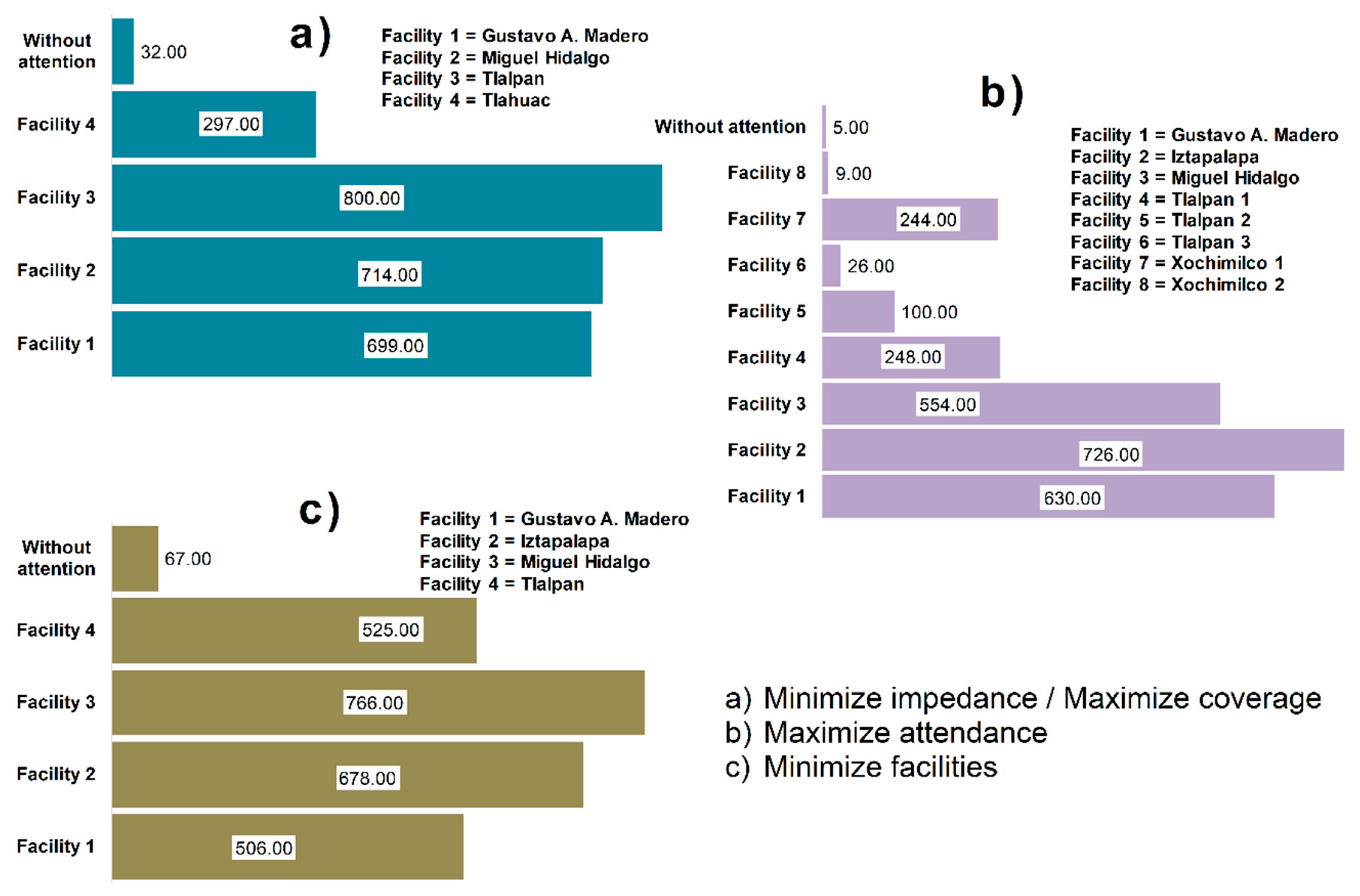
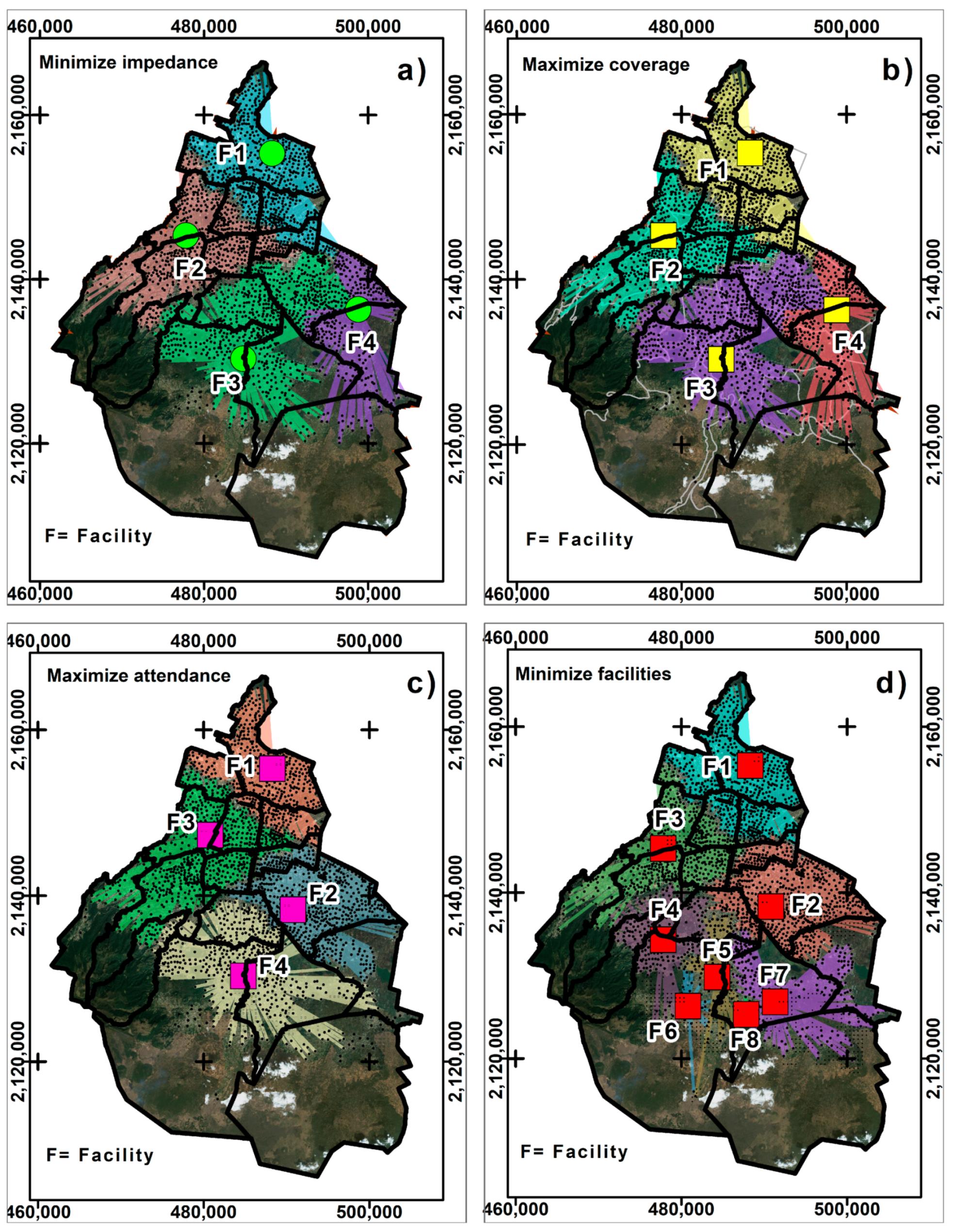
| Variables | i.1 | i.2 | i.3 | i.4 | Sum | Weight | |
|---|---|---|---|---|---|---|---|
| i.1 | Geotechnical zoning | 1.00 | 2.00 | 3.00 | 5.00 | 11.00 | 0.51 |
| i.2 | Flood zones | 0.50 | 1.00 | 1.00 | 2.00 | 4.50 | 0.21 |
| i.3 | Landslide zones | 0.33 | 1.00 | 1.00 | 1.00 | 3.33 | 0.15 |
| i.5 | Slopes | 0.20 | 0.50 | 1.00 | 1.00 | 2.70 | 0.13 |
| Total | 2.03 | 4.50 | 6.00 | 9.00 | 21.53 | 1.00 | |
| = 4.04, = 0.012, = 0.89 and = 0.014 < 0.1 | |||||||
| Variables | Levels | Normalized Level |
|---|---|---|
| Geotechnical zoning | Zone I | 3 |
| Zone II | 2 | |
| Zone III | 1 | |
| Flood zones | Outside flood zones | 3 |
| Within flood zones | 1 | |
| Landslide zones | Outside areas of landslides | 3 |
| Within areas of landslides | 1 | |
| Slopes | <5° | 3 |
| 5–25° | 2 | |
| >25° | 1 |
© 2019 by the authors. Licensee MDPI, Basel, Switzerland. This article is an open access article distributed under the terms and conditions of the Creative Commons Attribution (CC BY) license (http://creativecommons.org/licenses/by/4.0/).
Share and Cite
Araiza-Aguilar, J.A.; Gutiérrez-Palacios, C.; Rojas-Valencia, M.N.; Nájera-Aguilar, H.A.; Gutiérrez-Hernández, R.F.; Aguilar-Vera, R.A. Selection of Sites for the Treatment and the Final Disposal of Construction and Demolition Waste, Using Two Approaches: An Analysis for Mexico City. Sustainability 2019, 11, 4077. https://doi.org/10.3390/su11154077
Araiza-Aguilar JA, Gutiérrez-Palacios C, Rojas-Valencia MN, Nájera-Aguilar HA, Gutiérrez-Hernández RF, Aguilar-Vera RA. Selection of Sites for the Treatment and the Final Disposal of Construction and Demolition Waste, Using Two Approaches: An Analysis for Mexico City. Sustainability. 2019; 11(15):4077. https://doi.org/10.3390/su11154077
Chicago/Turabian StyleAraiza-Aguilar, Juan Antonio, Constantino Gutiérrez-Palacios, María Neftalí Rojas-Valencia, Hugo Alejandro Nájera-Aguilar, Rubén Fernando Gutiérrez-Hernández, and Rodrigo Antonio Aguilar-Vera. 2019. "Selection of Sites for the Treatment and the Final Disposal of Construction and Demolition Waste, Using Two Approaches: An Analysis for Mexico City" Sustainability 11, no. 15: 4077. https://doi.org/10.3390/su11154077




